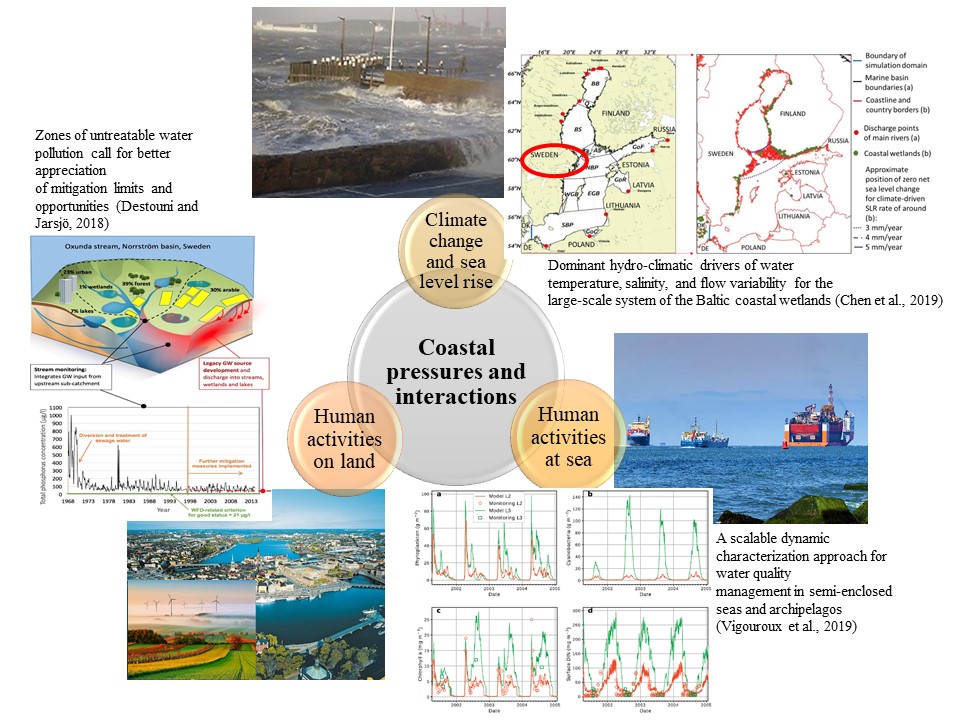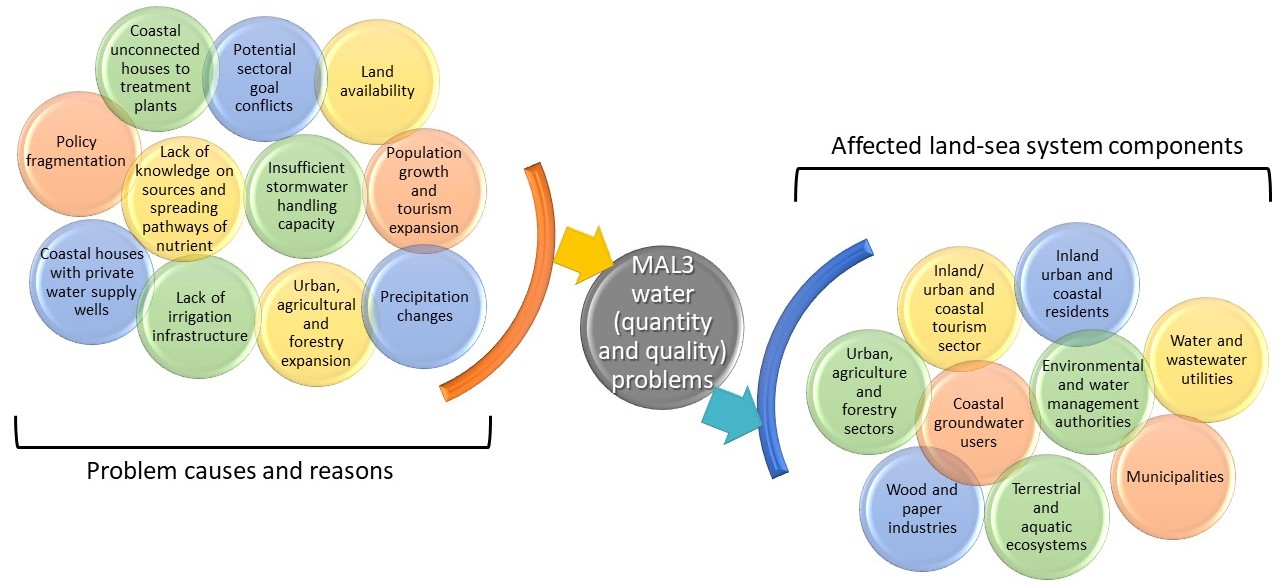Location and characteristics
The Norrström drainage basin (22 000 km²) comprises the major part of the Swedish water management district Northern Baltic Proper. For the case study economic and environmental issues will be considered at the scale of the Baltic Sea and local scale, including environmental and physical interactions between the two scales.
The basin is part of the fertile Swedish belt, characterised by extensive agriculture, and includes the Swedish capital Stockholm. An unresolved and well recognised problem for the coastal environment and its sustainable development is the human-driven eutrophication and associated hypoxia with recurring harmful algae blooms, caused by the combined nutrient emissions from households, agriculture, and industry. These impacts occur on the local/regional scale of the Swedish Norrström case and the macro-regional/cross-boundary scale of the whole-Baltic case.
Sustainable development solutions must consider the agricultural, urban, and industrial activities in the hinterland, the high and increasing population density, tourism development in the coastal zone, ongoing and future climate change, and their combined effects on the nutrient loads transported to the coast. The overarching problem and possibilities for addressing the problem are recognized in strategic planning and development plans at the local and regional scale.
How should rural, urban and coastal sectors, actors and activities interact to ensure sustainable development with no eutrophication or pollution of coastal and marine waters?
Ambition
- To connect and support policies and strategies for sustainable rural, urban and coastal development
- To create an integrated approach to mitigation of coastal-marine eutrophication and pollution
Eutrophication and pollution of inland, as well as coastal and marine waters, is a well-known, essential, but yet unresolved problem that needs to be handled and solved towards achieving sustainable regional development. Integrated understanding and synergistic, innovative, and efficient solution strategies are jointly sought and found for this overarching environmental problem - across the rural, urban and coastal sectors, and accounting for and including climate, land-use and other environmental and socio-economic changes in the region.
Coastal pressures and interactions in the cross-scale Norrstrom-Baltic Sea case

Actors
1. Green Growth sector
2. Blue Growth sector
3. Tourism
4. ICT sector
5. Authorities
Systems Modelling
To account for various key water-related issues and their possible changes under different hydro-climatic change and sector development scenarios, the following land-sea interactions are considered in the system dynamics (SD) modelling for MAL3:
- Water availability interactions among hydro-climatic components, water sub-systems, and various key active sectors on land and in the coast, and their possible change and development scenarios affecting current and further future sector activities and socio-economic characteristics in the region;
- Contributions of changes in hydro-climate and key active sectors to coastal water interactions and their changes, with focus on implications for seawater intrusion into fresh coastal groundwater, used and needed by the coastal population and their activities, as a feedback from the sea;
- Implications of all of the above for coastal nutrient loading and eutrophication, and opportunities for their mitigation and management.
These interactions address the following causes and affected system components of the water-related problems, as identified and discussed by local stakeholders in sectoral and multi-actor workshop for MAL3:

Considering data and model (result) availability, SD modelling in MAL3 focuses on the two following key topics:
- Cross-(sub)system/sector water availability exchanges (quantity perspective), and their implications for seawater intrusion into and quality of fresh coastal groundwater (quantity and quality perspective); and
- Cross-(sub)system/sector exchanges of waterborne nutrients and their loads through the catchment and towards and finally into the coastal waters (quality perspective).
System Dynamics (SD) Model Quantification
Various reported quantitative information in technical and scientific peer-reviewed publications and official reports are mainly considered for quantification of the two SD models in MAL3:
- Baresel, C., Destouni, G. (2005). Novel quantification of coupled natural and cross‐sectoral water and nutrient/pollutant flows for environmental management. Environmental Science and Technology, 39, 6182-6190 (https://doi.org/10.1021/es050522k)
- Bring, A., Rogberg, P., Destouni, G. (2015). Variability in climate change simulations affects needed long-term riverine nutrient reductions for the Baltic Sea, Ambio, 44, S381-S391 (https://doi.org/10.1007/s13280-015-0657-5)
- Cseh, M. (2009). Multi-approach comparison of nutrient flow modeling in the Norrström drainage basin. Master thesis of Environmental Engineering, Budapest University of Technology and Economics, Budapest, Hungary, and Stockholm University, Stockholm, Sweden.
- Destouni, G., Hannerz, F., Prieto, C., Jarsjö, J., Shibuo, Y. (2008). Small unmonitored near-coastal catchment areas yielding large mass loading to the sea. Global Biogeochemical Cycles, 22(4), GB4003 (https://doi.org/10.1029/2008GB003287)
- Hannerz, F., Destouni, G. (2006). Spatial characterization of the Baltic Sea Drainage Basin and its unmonitored catchments, Ambio, 35, 214-219 (https://doi.org/10.1579/05-a-022r.1)
- Helsinki Commission (HELCOM) (2013b). Review of the fifth Baltic Sea pollution load compilation for the 2013 HELOCM Ministerial Meeting. Baltic Sea Environment Proceedings, 141, Helsinki, Finland (https://helcom.fi/media/publications/BSEP141.pdf)
- Helsinki Commission (HELCOM) (2007) Baltic Sea Action Plan (https://helcom.fi/baltic-sea-action-plan/)
- Levi, L., Cvetkovic, V., Destouni, G. (2018). Data-driven analysis of nutrient inputs and transfers through nested catchments. Science of the Total Environment, 610-611, 482-494 (https://doi.org/10.1016/j.scitotenv.2017.08.003)
- Mazi, K., Koussis, A.D., Destouni, G. (2016). Quantifying a sustainable management space for human use of coastal groundwater under multiple change pressures. Water Resources Management, 30, 4063-4080 (https://doi.org/10.1007/s11269-016-1363-1)
- Swedish Environmental Protection Agency (Naturvårdsverket) (2016). Wastewater treatment in Sweden 2016 (https://www.naturvardsverket.se/Documents/publikationer6400/978-91-620-8809-5.pdf?pid=22471)
Scenario analysis
SD models in MAL3 can address the impacts of changes outlined in the figure below on associated inter-system/sector interactions and eventually on water-related problems in this MAL.

Various physical and socio-economic local/regional change/development that can be addressed by SD models in MAL3
CONTACT
Swedish MAL coordination
Stockholm University, Department of Physical Geography
Prof. Georgia Destouni (email:
Local partners of the Norrström/Baltic MAL
- SEI: Stiftelsen The Stockholm Environment Institute (SE)
- LUKE: Luonnonvarakeskus (FI)
- NIRAS: Niras Sweden AB (SE)
- CRAB: Campus Roslagen AB (SE)
- GLOB: Global Utmaning (SE)
